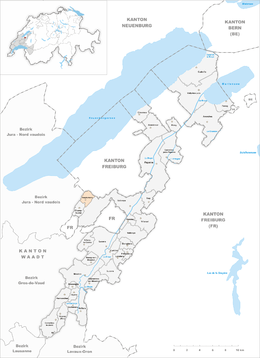Treytorrens (Payerne)
| Treytorrens | ||
|---|---|---|

Church of Saint-Jean-Baptiste in Treytorrens
|
||
|
||
| Coordinates: 46°46′N 6°48′E / 46.767°N 6.800°ECoordinates: 46°46′N 6°48′E / 46.767°N 6.800°E | ||
| Country | Switzerland | |
| Canton | Vaud | |
| District | Broye-Vully | |
| Government | ||
| • Mayor |
Syndic Etienne Gerbex |
|
| Area | ||
| • Total | 3.07 km2 (1.19 sq mi) | |
| Elevation | 666 m (2,185 ft) | |
| Population (Dec 2015) | ||
| • Total | 123 | |
| • Density | 40/km2 (100/sq mi) | |
| Demonym(s) | Les Treytorranais | |
| Postal code | 1538 | |
| SFOS number | 5828 | |
| Surrounded by | Champtauroz, Chavannes-le-Chêne, Combremont-le-Grand, Murist (FR), Nuvilly (FR) | |
| Website |
http://www.treytorrens.ch Profile (French), SFSO statistics |
|
Treytorrens is a municipality in the district of Broye-Vully in the canton of Vaud in Switzerland.
Treytorrens has an area, as of 2009[update], of 3.1 square kilometers (1.2 sq mi). Of this area, 2.31 km2 (0.89 sq mi) or 75.2% is used for agricultural purposes, while 0.64 km2 (0.25 sq mi) or 20.8% is forested. Of the rest of the land, 0.15 km2 (37 acres) or 4.9% is settled (buildings or roads).
Of the built up area, housing and buildings made up 1.6% and transportation infrastructure made up 2.9%. Out of the forested land, all of the forested land area is covered with heavy forests. Of the agricultural land, 59.6% is used for growing crops and 15.3% is pastures.
The municipality was part of the Payerne District until it was dissolved on 31 August 2006, and Treytorrens became part of the new district of Broye-Vully.
The blazon of the municipal coat of arms is Gules, three Fishes nainaint Argent.
Treytorrens has a population (as of December 2015[update]) of 123. As of 2008[update], 0.9% of the population are resident foreign nationals. Over the last 10 years (1999–2009 ) the population has changed at a rate of 0%. It has changed at a rate of -4.3% due to migration and at a rate of 3.5% due to births and deaths.
Most of the population (as of 2000[update]) speaks French (97 or 95.1%), with German being second most common (3 or 2.9%) and Italian being third (1 or 1.0%).
...
Wikipedia




